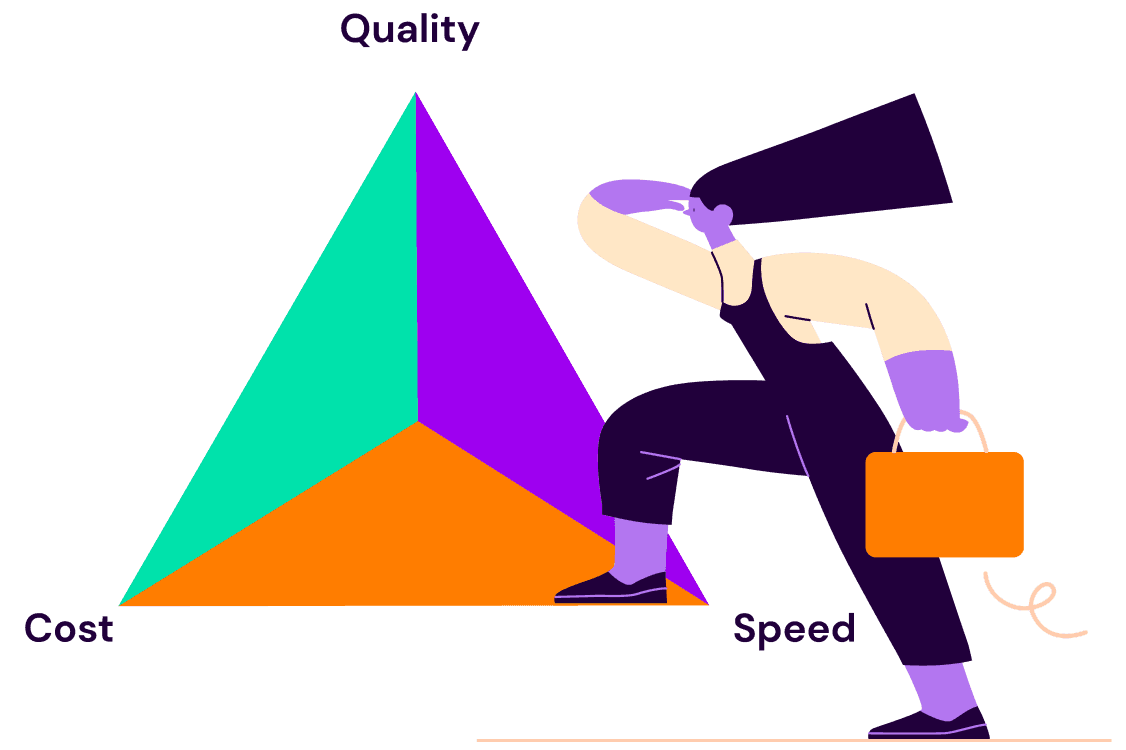
Back to blogs
A common goal among CHROs and talent leaders in today’s economic climate is to become an agile company. Workforce flexibility is needed to readily adapt to market changes, but implementing a long-term strategy is elusive for many organizations. Large companies have turned to investing in their employees’ career trajectories using an internal talent marketplace, and ahead, we share why this approach could prove successful for your own talent strategy.
You’ll learn how hiring internally supports critical business outcomes, see examples, and discover how one SeekOut customer uses a talent marketplace to make smarter hiring decisions and increase retention.
What are internal talent marketplaces?
An internal talent marketplace is a platform where organizations post open roles, projects, gigs, and learning and development opportunities at their company, and their employees can apply based on their career goals, skills, and interests.

By 2027, 35% of large enterprises will have implemented an internal talent marketplace according to Gartner
Modern platforms leverage AI technology to enable key components of long-term talent strategy. To keep employees engaged, AI-assisted platforms offer features such as suggested learning opportunities, mentor connections, and career paths. For managers and leaders, internal talent marketplaces provide a complete, up-to-date view of their employees’ work history, interests, and skills, allowing redeployment, upskilling, and future workforce planning.
Talent marketplaces benefit both the business and employees:
Businesses gain a holistic understanding of their workforce. Teams can easily identify talent across their organization and quickly match the right skills, experience, and people to roles or projects.
Employees own their career trajectory and growth opportunities. With transparency into their future at the company, employees are less likely to leave for outside opportunities.
Why internal hiring supports a holistic talent strategy
The talent function has historically been separated into two pillars: talent acquisition on one side and talent management on the other. Talent teams often turn to external hiring or passive sourcing for a role without considering an existing employee. Talent management is not often part of an organization’s hiring strategy, and this fragmented approach is sorely outdated.
How mature is your organization's talent strategy?
Take the assessmentToday’s talent landscape has undergone a complete paradigm shift: Employees churn in higher numbers, the talent shortage continues to grow, and technology is so sophisticated that talent teams are able to gather data and insights on talent pools more accurately than ever before. To adapt to market changes and remain relevant with employees and candidates, organizations need a holistic, multi-channel approach to their talent strategy that proactively keeps internal talent as a bedrock of future workforce planning.
Benefits of using an internal talent marketplace
An internal talent marketplace equips businesses to plan both short- and long-term strategies. The goal isn’t to dismiss external or passive sourcing entirely. Instead, tapping into multiple talent pools ensures you’re casting a wide net to match the right talent to any role—whether that role needs to be filled next week or six months from now. Ultimately, you’ll make smarter decisions knowing when to save money on an internal hire and when to dip into budget for an external hire.

Suggested reading: Every Talent Pool in One Spot: Simplify Sourcing with Cross-Channel Search
Build a dynamic workforce
Economic ups and downs are unavoidable. Many businesses aren’t equipped to respond to these changes and that usually leaves layoffs as the only option. A reduction in force sets a number of interruptions in motion to business operations: innovation stalls, business goals are delayed, and employee morale weakens.
According to a 2024 report by iCIMS, 86% of CHROs claim internal mobility as a top priority for their organizations this year. Adopting a talent marketplace enables the response strategy needed to achieve internal mobility and adapt to market changes as they arise. It provides organizations with a clear picture of how every employee’s skills, experience, and career aspirations align with immediate company needs to fit those people in the right roles. These practices are the foundation for becoming a skills-based organization.
Reduce total acquisition cost
The true cost of recruiting a new employee can vary, but organizations agree that it's an expensive practice. One talent firm estimates the total cost can be three to four times the position's salary. This figure includes the indirect costs of hiring: the time departmental leaders and managers are pulled away from reaching business outcomes because of the hours they have to dedicate throughout the hiring process.
An internal talent marketplace saves on total acquisition spend because an employe won’t require the same ramp-up time and training hours as an external hire. And when an employee follows a career trajectory—meaning there has been an expectation that they will fill a particular role—extra spend isn't necessary on job boards, advertising, interview time, and sourcing other candidates.
Prevent employee churn
According to Pew Research Center, 63% of workers quit their jobs in 2021 because there was no opportunity for advancement. A separate survey by PwC reports that 67% of workers say opportunities to learn new skills are a key factor in their decision to find employment elsewhere. When employees leave, their team experiences setbacks in goal completion, and morale can take a hit. Plus, a departing employee or mass layoffs may influence others to leave, too.

Suggested reading: Interview Questions for Internal Candidates
An internal talent marketplace demonstrates your organization’s ongoing commitment to employee growth. Most employees crave advancement and new challenges. A marketplace allows employees to take ownership of their careers, provides the stability and trust needed to remain with an organization long-term, and it sends a clear message that their futures are valued.
Foster inclusivity
An internal talent marketplace directly supports an organization's DEI strategy. AI can surface opportunities for employees who may not have applied on their own because of a perceived lack of qualifications. For example, women are less likely to apply for a role unless they believe they match all the role’s criteria.
An AI platform can infer skills from an employee’s profile and notify them of an opportunity they may have overlooked. “A digital talent marketplace...takes the guesswork out, which is critical to making sure we’re creating opportunities in an equitable and inclusive way,” said McKinsey Associate Partner Emily Fields. “[It] creates more transparency and visibility into open opportunities.”
Support strategic workforce planning
In a Fast Company survey of 200 boards of directors, 61% said workforce planning is a very/extremely important talent issue. Talent marketplaces directly impact workforce planning because they provide organizations with a clear, data-driven outlook of their employees’ skills availability. When aligned with talent trends in the market, organizations can easily identify skills gaps, where they are understaffed, spot future talent needs, and target which employees are prime to upskill and train for a future role.
Internal talent marketplace examples
An internal talent marketplace can look different across organizations, but many are more than just a job-matching tool. Here are some common components of these platforms.
Learning and development matching
Marketplaces with learning and development programs, such as SeekOut’s Career Compass, help upskill or reskill existing employees with learning tracks and courses that align with business goals. These programs can also connect employees to other members of the organization so they can gain valuable perspectives on the right skills for any career goals.

Taking on gigs to gain new skills
To support career trajectories, many internal talent marketplaces can match gigs across the organization to employees whose skills support those opportunities. For example, a design team may post a gig asking for help with collateral for an upcoming event. An employee who is interested in expanding their skills in design may apply to gain that experience and have a project to add to their professional portfolio.
Project staffing
For companies that work under contracts, speed is critical when assembling a team in a bid proposal. To staff projects quickly, talent teams can understand which parts of the employee population are able to support which projects, create cohorts of exceptional performers by role, and respond to bids for new work faster.
As contracts end, the organization can also proactively identify new work for employees, which cuts any cost associated with layoffs.
How Peraton uses SeekOut’s internal talent marketplace to curb turnover
Peraton is a national security and technology company that supports every branch of the U.S. Armed Forces and serves as a valued partner to government agencies. Their line of business requires them to fill roles for critical projects as quickly as possible with top talent who have relevant security clearances to perform the job.
Cari Bohley, Peraton’s Vice President of Talent Management, realized that her team needed an AI-powered talent marketplace to accomplish the following:
Better manage bid and staffing proposals. Running through massive candidate and employee data sets under tight deadlines is far too time-consuming for a small team and slows down their response time.
Increase employee retention. To prevent its employees from leaving for outside opportunities, Peraton needed an impactful way to demonstrate a strong sense of belonging. Keeping employees ensures they can move people throughout the organization quickly and tap into external talent only when necessary.
Unite their people data from disparate systems. Peraton wanted to better leverage its talent intelligence. Employee data was in its recruiting system, HRIS, and several bespoke systems, which made it difficult to gather real-time insights and enable career development efforts.
Peraton adopted SeekOut Grow’s Career Compass, a talent marketplace that uses AI to gather employee data and offer personalized career growth recommendations. Both employees and managers have better transparency into job opportunities, projects, learning resources, connections, and career paths. Internal job board applicants increased nearly 10% and the company has experienced an increase in engagement overall.
Read the full case Peraton case study for more details about their holistic approach to talent
Blog post: internal talent marketplaceIncrease your return on talent with SeekOut’s internal talent marketplace
SeekOut Grow is a comprehensive talent management solution that empowers you to grow, retain, and redeploy internal talent while helping your employees realize their development and advancement goals.
Gain an unparalleled view into your organization and employees with all your data in one place
Increase internal mobility and help employees connect to mentors and peers
Provide an array of courses and learning options to upskill
Staff business-critical gigs in record time
And much more
See it for yourself. Take a tour of SeekOut Grow.
See us in action
Learn how SeekOut unifies people data to help organizations reach their talent goals
Request a demo




